Read the Rivers SOS submission on BHP Billiton’s plans to mine on the Georges River, Appin (November 2005)
From its source just south of the township of Appin, the Georges River flows through the localities of Campbelltown, Liverpool, Bankstown and Sutherland before reaching the estuary at Botany Bay.
The Georges River – Botany Bay catchment is the most populous in NSW, with over 1.2 million residents, yet it also has significant tracts of land that are largely in a natural state. The Healthy Rivers Commission, in their 2001 Report on the Georges River, called on the NSW Government to protect these natural lands, which are vitally important for water quality, for aquatic and terrestrial habitat, and for “visual and recreational amenity.”

The township of Appin was founded almost 200 years ago. An early Appin resident carved the name “Marhnyes Hole” into surrounding rock in the Georges River.
Unfortunately the river near its source has since been wrecked by BHP Billiton’s longwall mines, which went under the river bed near Appin from 2000. More mines are planned along the river and under some major tributaries.
The Healthy Rivers Commission complained that they had been wrongly informed that the destruction of the nearby Lower Cataract River would not be repeated in the Georges River – it was.
Residents of Appin, surveyed by the company, were especially concerned about the fate of their popular local swimming hole and beauty spot, Marhnyes Hole, where generations had picnicked and learnt to swim. Although aware of this concern, BHP Billiton refused to modify its mine plans, and the NSW Government approved the inevitable damage.
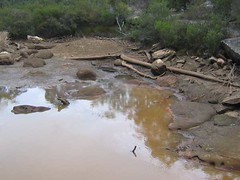 The northern end of Marhnyes Hole, photographed by Rivers SOS in May 2005.
The northern end of Marhnyes Hole, photographed by Rivers SOS in May 2005.
The typical red line around the water’s edge is caused by iron oxide. No-one much swims at Marhnyes Hole any more.
According to the NSW Scientific Committee: “The occurrence of iron precipitate and iron-oxidising bacteria is particularly evident in rivers where surface cracking has occurred … Loss of native plants and animals may occur directly via iron toxicity, or indirectly by smothering.”
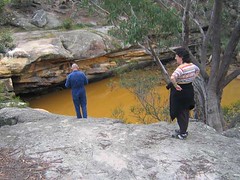 Rivers SOS members took this photo of the northern end of Marhnyes Hole in May, 2005, some years after longwall mines went underneath.
Rivers SOS members took this photo of the northern end of Marhnyes Hole in May, 2005, some years after longwall mines went underneath.
The colouration of the once crystal clear water has been described by a resident as “pumpkin soup” and is caused by iron oxides released from rocks fractured by mine impacts, along with other chemicals like manganese, nickel, zinc and sulphate, changing the water chemistry.
Not only has Marhnyes Hole been cracked, drained and polluted, but also there was a dangerous rockfall at the spot where children used to dive. BHP Billiton had to employ a security guard for several months to warn the children that diving in time-honoured fashion was no longer safe.
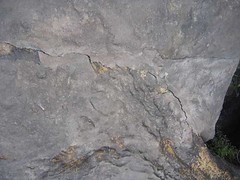 BHP Billiton say they spent over one million dollars trying to repair damage at Marhnyes Hole.
BHP Billiton say they spent over one million dollars trying to repair damage at Marhnyes Hole.
This is a close-up of one crack, taken in 2005, where the cement grouting has re-opened and started to crumble only a year or two after repairs were attempted.
Prior to mining the company drilled a stress-relieving slot deep into the rocks beside Marhnyes Hole; this not only looks ugly – like the grey cement grouting – but it obviously did not prevent major cracking and fracturing as planned.
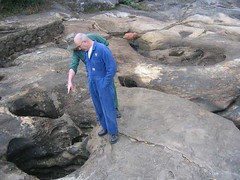 Local residents examining the cracking at Marhnyes Hole in 2005.
Local residents examining the cracking at Marhnyes Hole in 2005.
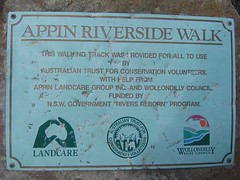 This sign was erected on a path along the Georges River near Marhnyes Hole.
This sign was erected on a path along the Georges River near Marhnyes Hole.
The NSW Government is trumpeting its “Rivers Reborn” programme, which strikes us as ironic given their complicity in ongoing damage to rivers from mine impacts.
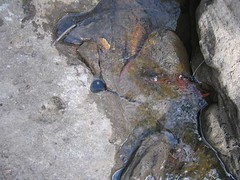 Typical of numerous unattractive and intrusive holes drilled in the Georges River bed by the company, for monitoring purposes.
Typical of numerous unattractive and intrusive holes drilled in the Georges River bed by the company, for monitoring purposes.
In 2006, the NSW Government – via Minister for Mineral Resources Ian Macdonald – approved three more of BHP Billiton’s longwall mines going right up to the river bank, just north of Marhnyes Hole. The river is further damaged. Two of the longwalls were a width of 305 m, unprecedented in the Southern Coalfield (the wider the longwall panel, the more severe the surface damage).
More mines along and even under the river will be approved in the future unless we can convince the government to listen to the advice of its own experts.
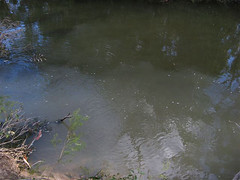 Upstream from Marhnyes Hole, two collieries pump their saline and acidic waste water into the Georges River – BHP Billiton’s West Cliff and Appin Collieries.
Upstream from Marhnyes Hole, two collieries pump their saline and acidic waste water into the Georges River – BHP Billiton’s West Cliff and Appin Collieries.
In fact, the company’s consultants, Ecoengineers, noted that mine discharges are the only water sources for this part of the river in dry periods. This is because the West Cliff Colliery has dammed up and diverted a major tributary, Brennans Creek.
The image to the left shows the polluted water of Brennans Creek mixing with the (relatively) unpolluted water of the Upper Georges River.
The colliery pumps its waste water into the dam, where it is mixed with Brennans Creek water and is released into the Georges River at intervals. The water in the river thus exceeds national water quality guidelines for dissolved nickel and zinc. Aquatic ecosystems are now described as “limited”.


Who the hell ever approved mining under the Georges, or any other river ? Were they delusional or just plain evil ?
its all about the $$$, they have no real concern for appin residents only their back pockets. im disgusted with these morons, they are destroying our pristine environment. when will enough be enough?
They’ll stop when there is nothing left, or when the greens come to power. The problem is education. If people were aware the true price of their energy, and the actual threat it poses to water and food sources, the companies would change their ways. Until then though, the companies will go about their business and pollute whatever they like. And the politicians enjoy the kickbacks provided by the companies, and do nothing about it. Barry Ofarrell came to power in 09 and promised “no new mines near aquifers”. So much for that. Its a sad, sorry state of affairs.